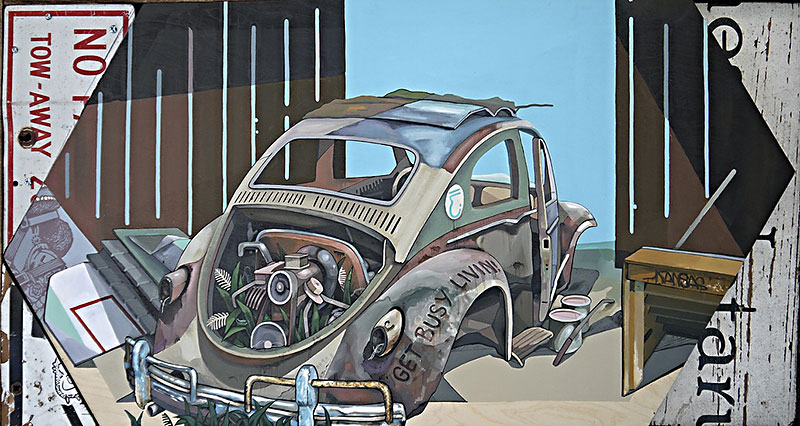"Jason Eatherly and Dave Lowell: Depth & Decay"
A fluid, graphic quality keeps the dissimilar work of these artists cohesive and makes visual candy that is pretty delicious
Reviewed by Sam Anderson-Ramos, Fri., May 5, 2017
It's the fluid, graphic quality of Jason Eatherly and Dave Lowell's work that makes "Depth & Decay" cohesive. This is important because the two artists' content is not especially similar. Lowell's The Ride, for instance, features a cutout of a vintage bather swan diving across a field of glass set in a reclaimed window pane. Eatherly's The Shell of a Long Lived Dream is a painting of a decrepit car, tires and windows missing, littered with red flowers and "parked" against a wilting basketball hoop like a blackened flower long dead. Lowell's is neat stencil work and glass, while Eatherly's is acrylic on a rotted slab of wood. It's the attitude that brings it all together. It's a swagger, a bravado that echoes slam poetry, a foot-stomping, hand-clapping visual style that is entertaining, even if it isn't surprising. Lowell's Jacket, a stencil on wood panel, looks like an Andy Warhol screenprint. A black leather jacket rests, cracked and shining, over a red background. It's bold, like Kenneth Anger's 1963 Scorpio Rising, a short film featuring homoerotic fetish play between bikers in leather, denim, and buckles. The only drawback to Lowell's Jacket is that it does so thoroughly remind me of other things, which on the one hand is deeply satisfying, like watching Pulp Fiction for the hundredth time, but on the other hand answers so many of its own questions that there isn't much left for the viewer to do.
That said, the visual candy in "Depth & Decay" is pretty delicious. Like The Shell of a Long Lived Dream, Eatherly's Potential for the Youth uses found material, though the wood surface seems to be fresh rather than used. Another vehicle, in this case a Volkswagen Bug, has been owned to the point of obliteration. It sits in a garage, rusted and maimed, weeds growing in its trunk, turned away from us as though it's ashamed. Old street signs form the corners of the piece, part of a metal tow-away sign, for example, and the faded white and black lettering of another, its message obscured. The words "GET BUSY LIVIN!" have been carved into the surface of one of the Bug's fenders.
My parents had a Volkswagen Bug when they were first married. Certainly they had a lot of "livin'" ahead of them. This weekend they celebrated their 45th anniversary. Their Bug is long gone, perhaps cultivating weeds somewhere like the one in Eatherly's painting. Potential's outlook on nostalgia and death is humorous, though I can't tell how dark that humor is. Are the weeds in the Bug's trunk an indication of life or another reminder of decay? I'm thinking it's the latter, only because that's the more predictable interpretation, and this doesn't seem to be the place for nuance. Bold is where it's at, gray areas be damned.
What Lowell and Eatherly's respective pieces most remind me of are great tattoo art, dramatic illustrations that can be dark, clever, and political, but which are also familiar enough to be immediately graspable. This is laudable. Norman Rockwell became famous for the visual question that answered itself. It's a style that satisfies my need to be shouted at, even dazzled, though only while I'm still looking. It's easy enough to forget after I've turned the page or looked away, which is another quality of a tattoo. Notice it in passing, raise an eyebrow, and move on.
"Jason Eatherly and Dave Lowell: Depth & Decay"
Art on 5th, 3005 S. Lamar, 512/481-1111, www.arton5th.comThrough May 7












